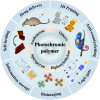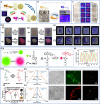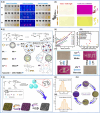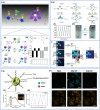Recent Development of Photochromic Polymer Systems: Mechanism, Materials, and Applications
- PMID: 38894714
- PMCID: PMC11184227
- DOI: 10.34133/research.0392
Recent Development of Photochromic Polymer Systems: Mechanism, Materials, and Applications
Abstract
Photochromic polymer is defined as a series of materials based on photochromic units in polymer chains, which produces reversible color changes under irradiation with a particular wavelength. Currently, as the research progresses, it shows increasing potential applications in various fields, such as anti-counterfeiting, information storage, super-resolution imaging, and logic gates. However, there is a paucity of published reviews on the topic of photochromic polymers. Herein, this review discusses and summarizes the research progress and prospects of such materials, mainly summarizing the basic mechanisms, classification, and applications of azobenzene, spiropyran, and diarylethene photochromic polymers. Moreover, 3-dimensional (3D) printable photochromic polymers are worthy to be summarized specifically because of its innovative approach for practical application; meanwhile, the developing 3D printing technology has shown increasing potential opportunities for better applications. Finally, the current challenges and future directions of photochromic polymer materials are summarized.
Copyright © 2024 Jindou Zou et al.
Conflict of interest statement
Competing interests: The authors declare that they have no competing interests.
Figures











Similar articles
-
A novel viologen-based hybrid crystalline material for photochromic glass films, information storage and anti-counterfeiting.Dalton Trans. 2024 Nov 5;53(43):17565-17570. doi: 10.1039/d4dt02513j. Dalton Trans. 2024. PMID: 39392740
-
Recent progresses on diarylethene based photochromic switches.Chem Soc Rev. 2004 Feb 20;33(2):85-97. doi: 10.1039/b302356g. Epub 2004 Jan 20. Chem Soc Rev. 2004. PMID: 14767504 Review.
-
Multiple Stimuli-Responsive Color-Changing Polymer Materials for Reversible Writing and Anti-Counterfeiting.ACS Appl Mater Interfaces. 2024 Aug 14;16(32):43064-43071. doi: 10.1021/acsami.4c10488. Epub 2024 Aug 2. ACS Appl Mater Interfaces. 2024. PMID: 39092612
-
Layered photochromic films stacked from spiropyran-modified montmorillonite nanosheets.RSC Adv. 2019 Apr 23;9(22):12325-12330. doi: 10.1039/c9ra01480b. eCollection 2019 Apr 17. RSC Adv. 2019. PMID: 35515825 Free PMC article.
-
Recent Progress in Photoresponsive Biomaterials.Molecules. 2023 Apr 25;28(9):3712. doi: 10.3390/molecules28093712. Molecules. 2023. PMID: 37175122 Free PMC article. Review.
Cited by
-
Combined Photopolymerization and Localized Photochromism by Aza-Diarylethene and Hemiindigo Synergy.Adv Mater. 2025 Jan;37(3):e2411223. doi: 10.1002/adma.202411223. Epub 2024 Nov 21. Adv Mater. 2025. PMID: 39573834 Free PMC article.
-
Panchromatic photochromic push-pull dyes featuring a ferrocene donor group.Mater Chem Front. 2025 Aug 13. doi: 10.1039/d5qm00412h. Online ahead of print. Mater Chem Front. 2025. PMID: 40822419 Free PMC article.
-
Three-Dimensional Printable Color-Modulation and Shape-Programmable Structures: An Encryption Key for Image Recognition Electronic Locks.Research (Wash D C). 2025 Apr 25;8:0666. doi: 10.34133/research.0666. eCollection 2025. Research (Wash D C). 2025. PMID: 40290136 Free PMC article.
References
-
- Li C, Iscen A, Palmer LC, Schatz GC, Stupp SI. Light-driven expansion of spiropyran hydrogels. J Am Chem Soc. 2020;142(18):8447–8453. - PubMed
-
- Mouraki A, Alinejad Z, Sanjabi S, Salehi-Mobarakeh H, Mahdavian AR. Magneto-responsive photochromic acrylic copolymer nanoparticles: An investigation into the mutual interactions and photoisomerization kinetics. Polymer. 2021;218: Article 123524.
-
- Sharifian MH, Mandavian AR, Salehi-Mobarakeh H. Effects of chain parameters on kinetics of photochromism in acrylic-spiropyran copolymer nanoparticles and their reversible optical data storage. Langmuir. 2017;33(32):8023–8031. - PubMed
-
- Yang R, Jiao Y, Wang B, Xu B, Tian W. Solid-state reversible dual fluorescent switches for multimodality optical memory. J Phys Chem Lett. 2021;12(4):1290–1294. - PubMed
-
- Brändler L, Niklaus L, Schott M, Löbmann P. Photochemical precharging of tungsten trioxide for enhanced transmittance modulation in flexible electrochromic devices. Adv Mater Technol. 2023;8(11):2201903.
LinkOut - more resources
Full Text Sources

